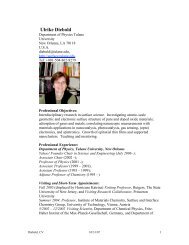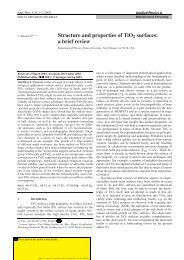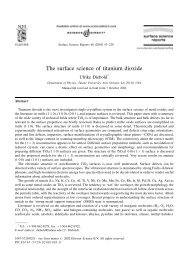Oxygen adsorption on Cu/ZnO (0001) –Zn - Diebold, Tulane
Oxygen adsorption on Cu/ZnO (0001) –Zn - Diebold, Tulane
Oxygen adsorption on Cu/ZnO (0001) –Zn - Diebold, Tulane
Create successful ePaper yourself
Turn your PDF publications into a flip-book with our unique Google optimized e-Paper software.
Results and Discussi<strong>on</strong><br />
Previous studies by STM of <strong>Cu</strong> growth <strong>on</strong> <strong>ZnO</strong> 17, 18, 19, 20 showed the formati<strong>on</strong> of well<br />
defined clusters. For moderately high <strong>Cu</strong> coverages, <strong>Cu</strong>(111) LEED spots were observed,<br />
indicating a strict crystallographic relati<strong>on</strong>ship of the <strong>Cu</strong> clusters with respect to the <strong>ZnO</strong><br />
substrate. In order to probe the crystalline nature of the <strong>Cu</strong> deposits <strong>on</strong> our sample, we<br />
performed X-ray photoelectr<strong>on</strong> diffracti<strong>on</strong> studies (XPD) al<strong>on</strong>g the 1 100 azimuth of<br />
the <strong>ZnO</strong> substrate. The <strong>Cu</strong> intensity variati<strong>on</strong>s (2 p 3/2 ), versus the polar angle were<br />
m<strong>on</strong>itored after depositing 0.3 ML, 1 ML and 5 ML at room temperature <strong>on</strong> the clean<br />
<strong>ZnO</strong> (<strong>0001</strong>)-Zn terminated surface. The results of these measurements are shown in<br />
Figure 1. For 0.3 ML (trace (i)) the deposited film shows no special features as a<br />
functi<strong>on</strong> angle, bey<strong>on</strong>d the instrumental resoluti<strong>on</strong>. At 1ML (trace (ii)) two weak peaks<br />
appear for 18º and 36º, respectively. Both peaks show a higher intensity for 5ML (trace<br />
(iii)). No variati<strong>on</strong>s in the intensity as a functi<strong>on</strong> of angle are expected for emissi<strong>on</strong> from<br />
an atomically flat surface below 1 ML coverage, if the <strong>Cu</strong> atoms are distributed in a<br />
uniform film or if they form a locally disordered thicker <strong>Cu</strong> film. The fact that we see<br />
two weak peaks at 1ML coverages is an indicati<strong>on</strong> of cluster growth. If the clusters are<br />
formed by <strong>Cu</strong>(111) nanoscale crystals, with the 111 directi<strong>on</strong> al<strong>on</strong>g the surface normal,<br />
and azimuthally oriented in the plane, with <strong>on</strong>e of the high symmetry directi<strong>on</strong>s al<strong>on</strong>g<br />
the 1 100 substrate directi<strong>on</strong>s, the str<strong>on</strong>gest forward focusing peaks are expected at 19º<br />
and -35º (insert in Figure 1). We see both peaks for positive values of the detecti<strong>on</strong><br />
angle; indicating that both possible orientati<strong>on</strong>s of the copper clusters are formed during<br />
growth. For both of these clusters orientati<strong>on</strong>s, the 111 directi<strong>on</strong> is parallel to the<br />
substrate normal, but the ! 112" azimuth is either parallel or antiparallel to the <strong>ZnO</strong><br />
1100 directi<strong>on</strong>.<br />
These results are c<strong>on</strong>sistent with previous measurements for thicker layers (>5 ML), in<br />
which <strong>Cu</strong>(111) LEED spots have been observed in additi<strong>on</strong> to the <strong>ZnO</strong> substrate<br />
maxima. 20<br />
Yoshihara et al. 16 have studied the variati<strong>on</strong> of the <strong>Cu</strong> 2p 3/2 peak intensity as a<br />
functi<strong>on</strong> of polar angle al<strong>on</strong>g the same azimuth at low coverages (0.41 and 0.98 ML).<br />
6







